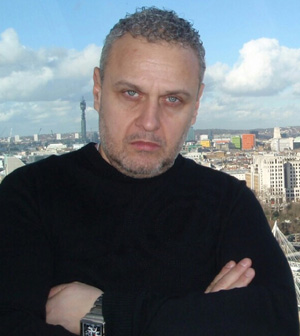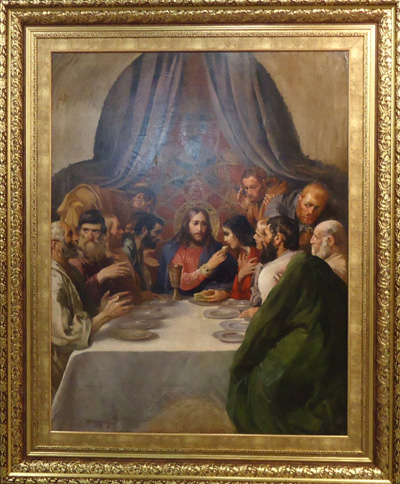An exceptional painting with mysterious fate came out of oblivion and caused admiration and amazement. The painting depicts one of the most popular biblical plots – the Last Supper of Jesus and his Disciples. However, this masterpiece was not painted by any Western-European artist. It was painted by the celebrated Bulgarian artist of Czech descent Ivan Mrkvička.
The painting was perhaps an elegant decoration in an aristocratic saloon and later sank into oblivion amidst moisture, dust and mold. Thirty years ago Ivan Mrkvička’s painting the Last Supper became part of the private collection of gallerist Dimitar Indzhov from Plovdiv. He bought the painting in a terrible condition and had to restore it several times afterwards until it finally regained its original look. The Bulgarian collector did not provide details how and under which circumstances he found Mrkvička’s masterpiece which is now on display at Shipka 6 gallery (the exhibition space of the Union of Bulgarian Artists) downtown Sofia for the first time. Currently, the Union of Bulgarian Collectors is presenting paintings of Bulgarian artists in that gallery.
Although it presents a widely-used plot, Mrkvička’s Last Supper is raising questions, rather than merely describing a painfully familiar scene where Jesus says the following: “Truly I tell you: one of you will betray me – one who is eating with me. ” – Mark 14: 12-21. And here comes the mystery: who is the person standing near the left shoulder of our Savior – the youngest of all twelve disciples John the Apostle or Mary Magdalene (Mary of Magdala)?
 “I cannot give a definite answer, because it requires a very serious research, but the person sitting to the left of Jesus may be Marie Magdalene instead of John the Apostle, especially if we believe in conspiracy theories, Dan Brown’s novels and The Priory of Sion (The Order of Sion), according to which Jesus Christ had children from Mary Magdalene, Dimitar Indzhov says. We can also refer to the fact that the apocryphal knowledge started to vanish. If we look at Mrkvička’s Last Supper we will see Jesus handing a piece of bread to the person standing to his left. We can see plenty of emotions on the faces of the apostles – some of them are lost in thoughts, others look shocked and worried.”
“I cannot give a definite answer, because it requires a very serious research, but the person sitting to the left of Jesus may be Marie Magdalene instead of John the Apostle, especially if we believe in conspiracy theories, Dan Brown’s novels and The Priory of Sion (The Order of Sion), according to which Jesus Christ had children from Mary Magdalene, Dimitar Indzhov says. We can also refer to the fact that the apocryphal knowledge started to vanish. If we look at Mrkvička’s Last Supper we will see Jesus handing a piece of bread to the person standing to his left. We can see plenty of emotions on the faces of the apostles – some of them are lost in thoughts, others look shocked and worried.”
While all painters have recreated the Last Supper horizontally, Ivan Mrkvička opted for a vertical and pyramidal composition in which human figures are densely arranged. This way they are not static but appear as dynamic and vivid images fraught with a lot of psychological expression which derives from the position of their heads and gestures.
 “In many of the paintings in which the Last Supper is depicted the image of Jesus Christ exceeds the corporal, the material and the table is laid with only a wooden goblet, a few empty saucers and some bread”, the collector also says and points out that here the goblet is reminiscent of the Holy Grail in other interpretations. „With a plethora of ornaments it looks like an expensive royal chalice. Christ’s clothing is also royal, and it even has decoration”, says Dimitar Indzhov and recalls that Jesus was dubbed the King of the Jews. Just like in Leonardo's masterpiece Jesus here he has no halo. There are also a few curious signs behind the drapery and especially one of them just behind Christ. And the question is whether he has a halo, or there is simply an optical illusion produced by this sign in the wall.
“In many of the paintings in which the Last Supper is depicted the image of Jesus Christ exceeds the corporal, the material and the table is laid with only a wooden goblet, a few empty saucers and some bread”, the collector also says and points out that here the goblet is reminiscent of the Holy Grail in other interpretations. „With a plethora of ornaments it looks like an expensive royal chalice. Christ’s clothing is also royal, and it even has decoration”, says Dimitar Indzhov and recalls that Jesus was dubbed the King of the Jews. Just like in Leonardo's masterpiece Jesus here he has no halo. There are also a few curious signs behind the drapery and especially one of them just behind Christ. And the question is whether he has a halo, or there is simply an optical illusion produced by this sign in the wall.
“Judas Iscariot usually sits somewhere at one end of the table or is painted in a shadow like in Leonardo’s piece, and he is the only one without a halo”, Dimitar Indzhov comments. “In the Mrkvička version however he is neither at the end of the table, nor in the shadow. He is behind John (Mary Magdalene) and has a full-face position. For the first time Judas is portrayed so frontally, almost like Christ – stooping, shame-faced, holding a purse as a hint of the thirty silver pieces for which he would betray Jesus.”
It is not as yet clear when Ivan Mrkvička painted his work, because the date on the canvas is not legible. The collector however supposes that it was painted in Bohemia (today the Czech Republic) – before the artist emigrated to Bulgaria in 1881 and became one of the founders of Bulgaria’s modern post-Liberation painting. And one of the explanations why Ivan Mrkvička preferred to hide his masterpiece behind the walls of a private home appears too trivial – he did not want to call down the anger of the Church for disputing some of its canons.
English version: Kostadin Atanasov, Daniela Konstantinova
Photos: Diana TsankovaOne of the most colourful and intriguing places of any city, town or village is its marketplace. Whether it is a daily event or happens on a special day of the week, whether there are specifics to the produce it offers or not, the marketplace is a..
The president of the Bulgarian Women and Families Club in Hamburg, Emilia Jucker, presents her paintings to the Chicago public for the second time. This time her exhibition is dedicated to the 30th anniversary of the cooperation between the two cities on..
"I have ordered inspections of all theaters to find out whether there are schemes for siphoning off state funds in other places", caretaker Minister of Culture Nayden Todorov told Nova TV. The comment follows findings of financial abuse in the towns..

+359 2 9336 661
